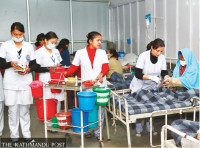Miscellaneous
Delhi: A city of two tales
I do not recall how old I was when I had encountered a giant, black-cover book in my father’s bookshelf titled Delhi: The Emperor’s City. The book, which was full of pictures and descriptions of historical monuments and sites, was perfect for a small child. The pictures of the beautiful forts, havelis, gates and bridges fascinated me.
Astha Wagle
Delhi: The Emperor’s City
I do not recall how old I was when I had encountered a giant, black-cover book in my father’s bookshelf titled Delhi: The Emperor’s City. The book, which was full of pictures and descriptions of historical monuments and sites, was perfect for a small child. The pictures of the beautiful forts, havelis, gates and bridges fascinated me. Perhaps, it was then that I first developed my fondness for monuments and architecture. The images of the Red Fort, Jama Masjid, Kashmiri Gate, Delhi Gate, Chandni Chowk and Shahjahanabad from the book are still fresh in my mind. If I ever go to Delhi, I will visit those places, I thought. To me Delhi truly seemed like an Emperor’s city.
I had never been out of Nepal before and had no idea about Delhi or India apart from the glimpses I received from books and films. I had assumed that it would be more or less the same as Kathmandu (It wasn’t. I realised after spending a few months) hence, I was very excited when I was accepted into an Indian University on the outskirts of Delhi. I thought I could finally visit those landmarks, monuments and ruins I always dreamt of visiting.
First impression
I had landed in the Emperor’s city in mid-August. Upon disembarking, I realised that Delhi was not just an ancient city of Emperors, but also a modern metropolis. With carpeted floors, moving walkways, and a gigantic yet well managed interior, the Delhi airport resembled a five-star hotel. I was startled by this foreign land even before stepping into the city. Even the sign boards of prepaid taxis had intrigued me as I had only heard of prepaid SIM cards before. Nonetheless, I hired one and made my way out of the airport. It was then that I got a real taste of Delhi’s torrid heat and humidity.
As I left the airport, I saw my first glimpses of the real life Delhi. I was awestruck. The roads were wide, clean and blacktopped without any potholes or damaged surface. Footpaths were well maintained. Overhead bridges were present at regular intervals and some of them had electrical escalators. Most importantly, there were trees—not plants or saplings but actual huge trees—on either side of the roads. There were also open spaces, parks and gardens. Delhi is not a concrete jungle like Kathmandu. It is a different world—a planned and well managed capital city.
Before arriving in Delhi, I had done some research and found out that nineteen million people resided here. I had expected Delhi to be crowded and chaotic, but I did not find it so. I did not witness the great masses of people during my first ride around the city. As I travelled farther, I saw more of the city. There were flyovers and overpasses. Six to seven roads met at junctions. There were public toilets at regular intervals. Streets were named. Roads had street signs making them easily navigable. Delhi was different and more advanced than Kathmandu. I was impressed and somewhat smitten by the Emperor’s city.
Delhi: City of 19 million
My first impression of Delhi did not remain unchanged. On my very first ride, I saw the rash driving of taxi and auto drivers. There were traffic congestions at every junction. Passengers in autos were packed like sardines in a can, and the drivers drove like Formula One racers. What a combination!
On the way to my college, an unusual sight—a plateau with rising smoke on the flat terrains of Delhi—caught my attention, which brutally murdered my notion of the Emperor’s city. It was a landfill. A plateau had been formed by the continuous deposition of waste. According to the taxi driver, waste was burned 24/7 in an eternal fire. That incident made me realise that Delhi is not an Emperor’s city but the city of 19 million people, most of whom struggled to scrape a living in desperate circumstances.
Over the years, I learned that Delhi is the epitome of homelessness and destitution. The fancy overhead bridges, which had once fascinated me, now repel me because in the night they are also shelter for the thousands of homeless people who have nowhere else to go. The bridges are an ironic symbol of the city’s inability to mend the disparity between its rich and poor. Three districts in the National Capital Territory of Delhi—Central, New Delhi, and North—rank third, fifth, and sixth, respectively, in terms homelessness. Urban poverty marks the city. You can always find people begging outside metro stations, on sidewalks and overhead bridges. Children working as peddlers are commonplace. Old people, who should be lying comfortably in beds, drive autos for15 hours a day to meet the cost of living in this city.
Furthermore, Delhi is hardly a paragon of infrastructure. The excellent road networks, reputed school and universities, extensive metro, gigantic multiplexes, massive corporate buildings, top restaurant chains are all catered to the need of the rich, upper class people. They have no bearing in the lives of the majority who work 15 hours a day just to eke out a living. Old Delhi has alleys where only two people could pass side by side, long stretches without trees or greenery, and plastic and organic waste blanketing the surface of roads. Open drainage is also a problem. The fetid stench of open sewers is unrelenting and a hazard to the health of slum dwellers who live in its midst.
The air quality of Delhi is continuously degrading. It is one of the most polluted capital cities in the world. If one stays in Delhi for a year, s/he will realise that the hot summers and cold winters are characteristic of the weather there. A thick layer of smog envelopes the atmosphere of Delhi and NCR cities at the beginning of winter which peaks post-Diwali and post-harvest and drastically increases pollution. The yearly smog is so dense at times that visibility is reduced to one metre or two metre and is worsened by human activities as people still allegedly use banned firecrackers and farmers burn leftover crops. Last November, the levels of PM2.5 in Delhi reached 710 micrograms per cubic metre, 11 times more than the World Health Organisation’s safety limit. Not just smog, Delhi also witnesses occasional storms and dust storms which hinder people’s day to day activities, increase health hazards and even cause deaths. Delhi’s extreme forms of weather which are intensified by pollution have proven to be a serious threat to the people for the past few years.
Delhi today
Delhi is no longer the Emperor’s grand city. It has within it remnants of the past—a rich history carved by trade and conquest—but today, it is in the process of redefining itself. Delhi has transformed into a modern mega-metropolis with its own mega-problems. A melting pot of different classes, ethnicities and religions, Delhi has its charms but also has its pitfalls and frustrations. It is a city of 19 million people, and to be a great city again it needs to also accommodate the needs of its poor and marginalised on the backs of whom all this ‘development’ was wrought.




 28.43°C Kathmandu
28.43°C Kathmandu










